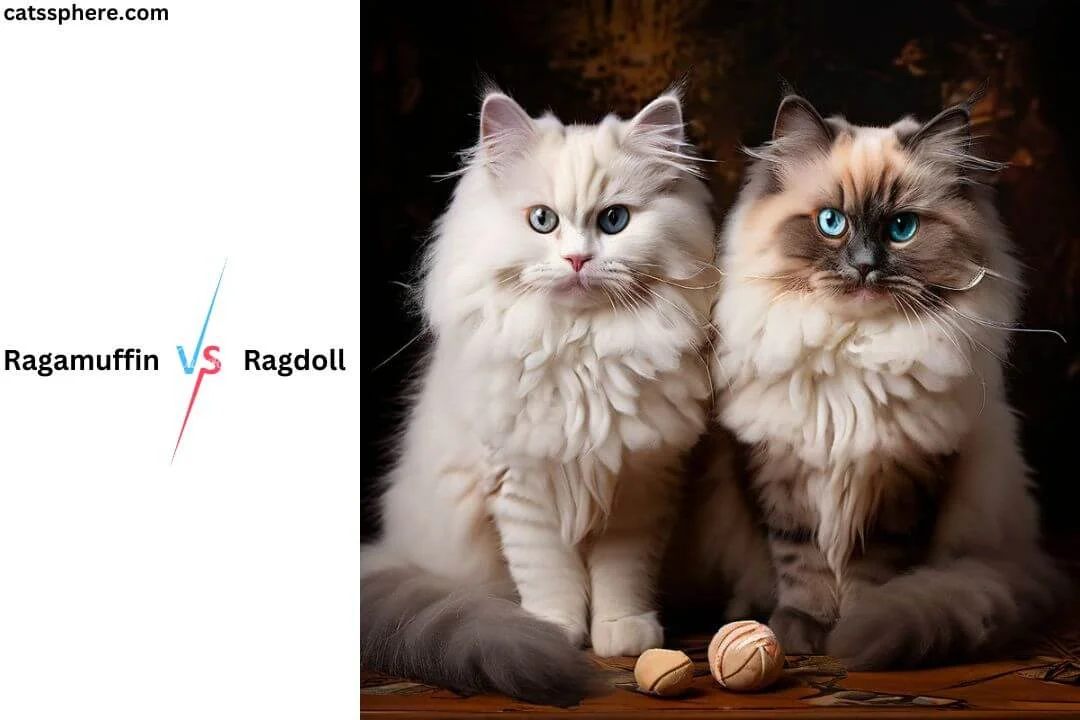When it comes to choosing a feline companion, understanding the unique traits of different breeds is crucial. Ragamuffin vs Ragdoll cats are two popular breeds that often capture the hearts of cat lovers. Both breeds are known for their charming personalities and striking appearances, but they do have distinct differences. This detailed comparison will help you decide which breed is the best fit for your lifestyle.
Origins and History
Ragdoll History
The Ragdoll breed was developed in the 1960s by Ann Baker, a breeder in Riverside, California. The breed started with a white domestic long-haired cat named Josephine, who produced kittens with unique, docile temperaments and striking blue eyes. Baker selectively bred these kittens to establish the Ragdoll breed, known for their large size, gentle nature, and plush coats. The breed quickly gained popularity due to their affectionate nature and striking appearance.
Ragamuffin History
Ragamuffins share a part of their history with Ragdolls. In the 1990s, a group of breeders separated from the Ragdoll breed to develop a distinct line with greater genetic diversity. These breeders focused on creating a cat with a more varied appearance and robust health. The Ragamuffin breed was officially recognized as separate from Ragdolls in 1994. While they share some characteristics with Ragdolls, Ragamuffins have their own unique traits that set them apart.
Physical Characteristics
Size and Build
Both Ragamuffins and Ragdolls are known for their large size. Ragdolls are typically slightly larger, with males weighing between 15-20 pounds and females between 10-15 pounds. Ragamuffins are also sizable, with males weighing around 15-20 pounds and females slightly less, usually between 10-15 pounds. Both breeds have a muscular build with broad chests and sturdy legs.
Coat and Colors
Ragdolls are famous for their silky, semi-longhaired coats that come in a variety of patterns, including colorpoint, mitted, and bicolor. Their coats are relatively easy to maintain despite their length, requiring regular grooming to prevent matting.
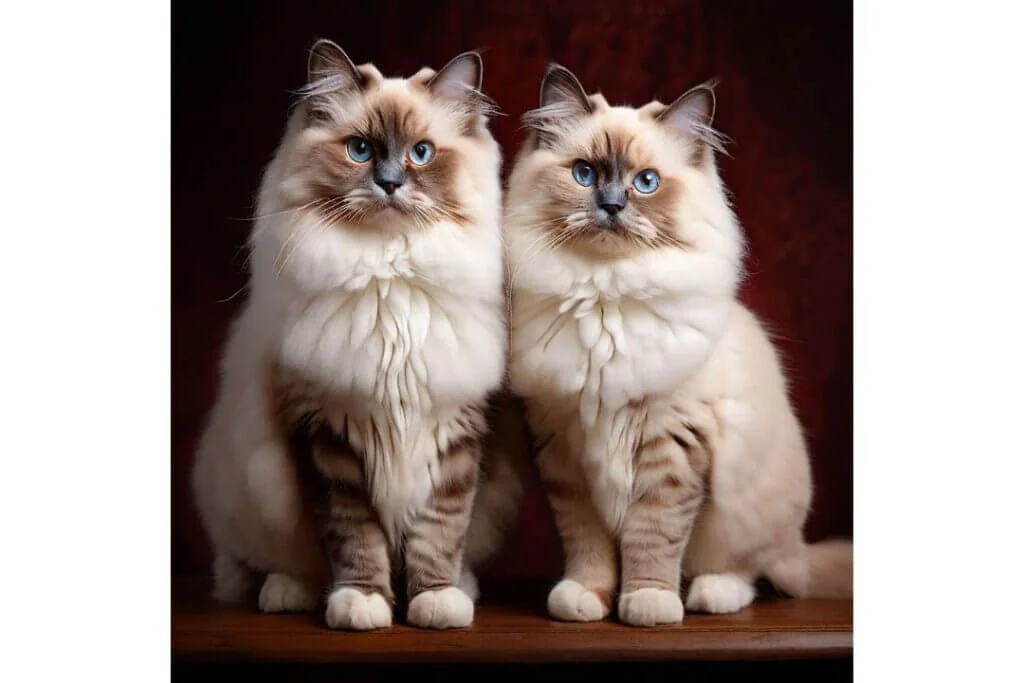
Ragamuffins have a similar coat type, but it tends to be even softer and plushier. They come in a wider variety of colors and patterns than Ragdolls, including solids, tortoiseshells, and tabbies. Regular grooming is essential to keep their coats looking their best.
Facial Features
Ragdolls are known for their striking blue eyes, which are large and oval-shaped. They have a gentle, sweet expression, with a slightly rounded muzzle and medium-sized ears that tilt forward.
Ragamuffins, on the other hand, have walnut-shaped eyes that can come in any color, including blue, green, gold, and odd-eyed (two different colored eyes). Their faces are more rounded, with fuller cheeks and a sweet, open expression. Their ears are medium-sized and set slightly to the side, enhancing their expressive look.
Personality and Temperament
Ragdoll Personality
Ragdolls are often described as “puppy-like” because of their docile and affectionate nature. They enjoy being around people and often follow their owners from room to room. Ragdolls are typically laid-back and are known to go limp when picked up, hence the name “Ragdoll.” They are great with children and other pets, making them ideal family companions.
Ragamuffin Personality
Ragamuffins are equally affectionate but tend to be more playful and curious. They are known for their friendly and social nature, often greeting visitors at the door. Ragamuffins are highly adaptable and enjoy interactive play. They form strong bonds with their families and get along well with children and other pets. Their playful nature makes them a delightful addition to any household.
Health and Lifespan
Common Health Issues
Both breeds are generally healthy, but they can be prone to certain genetic conditions. Ragdolls are at risk for hypertrophic cardiomyopathy (HCM), a common heart disease in cats. Regular veterinary check-ups are essential to catch any potential health issues early.
Ragamuffins can also be prone to HCM, as well as polycystic kidney disease (PKD). Responsible breeders screen for these conditions to ensure healthy kittens. Regular veterinary care and a healthy diet can help mitigate these risks.
Life Expectancy
Ragdolls typically live between 12-15 years, though with proper care, some can live even longer. Ragamuffins have a similar lifespan, averaging around 12-16 years. Providing a balanced diet, regular exercise, and routine veterinary care can help ensure a long, healthy life for both breeds.
Care and Maintenance
Grooming Requirements
Both Ragamuffins and Ragdolls have semi-longhaired coats that require regular grooming. Brushing their coats two to three times a week will help prevent matting and reduce shedding. Regular grooming sessions also provide an excellent opportunity to check for any skin issues or parasites.
Diet and Nutrition
A high-quality diet is essential for maintaining the health and vitality of both breeds. Protein-rich cat food that meets their specific nutritional needs is recommended. Monitoring their weight and adjusting their diet as necessary can help prevent obesity, which can lead to other health issues.
Exercise and Enrichment
While both breeds are relatively laid-back, they still require regular exercise and mental stimulation. Interactive toys, puzzle feeders, and regular playtime can help keep them active and engaged. Providing scratching posts and climbing structures can also contribute to their physical and mental well-being.
Suitability as Pets
Family Compatibility
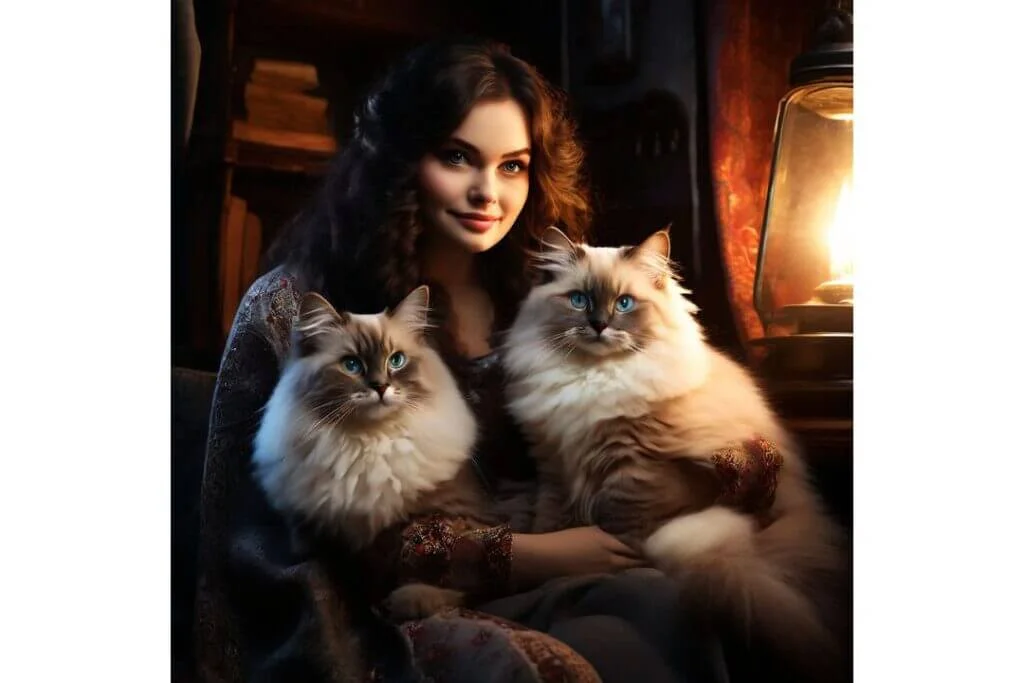
Ragdolls and Ragamuffins are both excellent choices for families. Ragdolls’ calm and gentle nature makes them perfect for households with young children and other pets. They are patient and rarely display aggressive behavior.
Ragamuffins are also great with families due to their playful and friendly demeanor. They enjoy interacting with children and can adapt well to various household environments. Their social nature makes them excellent companions for families of all sizes.
Living Environment
Both breeds are adaptable to various living conditions. Ragdolls can thrive in apartments as long as they receive adequate attention and stimulation. They are known for their indoor-only lifestyle, as they are not street-savvy and can be at risk if allowed to roam outside.
Ragamuffins are also well-suited to apartment living but appreciate more space to explore. Providing plenty of toys and climbing structures can help keep them entertained. Like Ragdolls, Ragamuffins are best kept indoors for their safety.
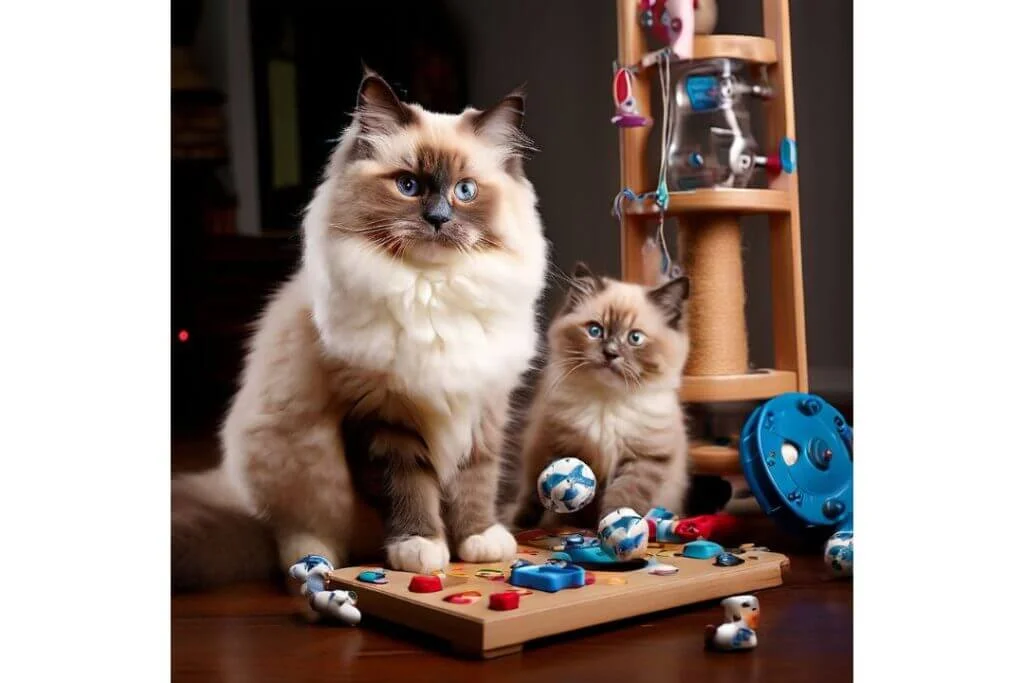
Cost and Availability
Initial Cost
The initial cost of a Ragamuffin or Ragdoll kitten can vary significantly based on the breeder, pedigree, and location. Ragdoll kittens typically range from $800 to $2,500, while Ragamuffin kittens can cost between $900 and $2,000. It’s essential to choose a reputable breeder who prioritizes the health and well-being of their cats.
Ongoing Expenses
Owning a Ragamuffin or Ragdoll involves ongoing expenses, including food, grooming supplies, and regular veterinary care. Budgeting for annual check-ups, vaccinations, and potential health issues is crucial. Additionally, investing in quality food and engaging toys can contribute to their overall well-being.
Are Ragdoll Cats Cuddly? Discover Their Affectionate Nature
How Are Ragdoll Cats with Dogs? Understanding Their Unique Bond
Breeding and Recognition
Breed Standards
Both Ragamuffins and Ragdolls have specific breed standards set by cat associations. These standards outline the ideal physical and temperamental traits for each breed. For Ragdolls, the standards include a large, muscular body, striking blue eyes, and a silky coat. Ragamuffins’ standards emphasize their plush coat, rounded features, and affectionate nature.
Recognition by Cat Associations
Ragdolls are recognized by major cat associations such as The International Cat Association (TICA) and the Cat Fanciers’ Association (CFA). They have gained widespread popularity and are often seen in cat shows.
Ragamuffins are also recognized by TICA and CFA, though they are less common in cat shows compared to Ragdolls. Despite this, their popularity is growing as more people discover their charming personalities and beautiful coats.
Conclusion: Ragamuffin vs Ragdoll
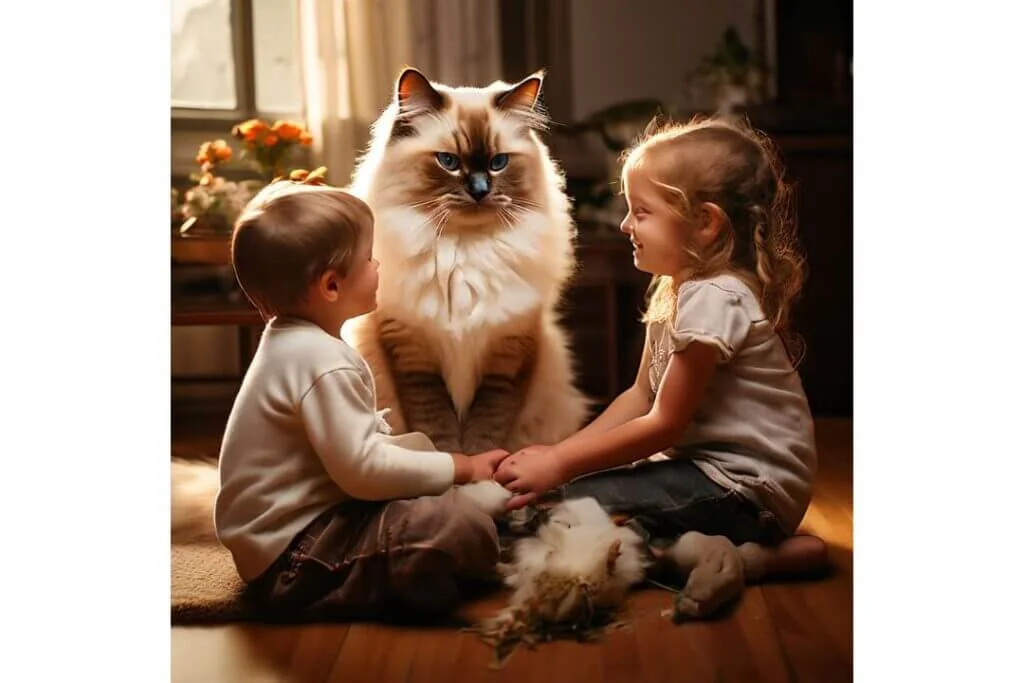
In conclusion, both Ragamuffin and Ragdoll cats make delightful companions, each with their distinct traits and characteristics that cater to different preferences. Ragdolls are renowned for their calm, affectionate demeanor and mesmerizing blue eyes, making them ideal pets for families seeking a gentle and loving companion. Their laid-back nature and preference for indoor living further enhance their appeal, particularly for those residing in smaller spaces or apartments.
On the other hand, Ragamuffins are known for their playful and friendly disposition, coupled with a diverse range of coat colors and patterns. These cats are perfect for those who desire an interactive and social pet that thrives on engagement and activity. Ragamuffins’ outgoing personality makes them a joy to have in households that appreciate a lively and affectionate feline presence.
When choosing between a Ragamuffin and a Ragdoll, it is essential to consider your lifestyle, living environment, and personal preferences. Both breeds offer unique qualities that can bring immense joy, love, and companionship to any home. Whether you prefer the serene and affectionate nature of the Ragdoll or the playful and sociable spirit of the Ragamuffin, either breed is sure to enrich your life with their endearing presence.
FAQs
Are Ragamuffins hypoallergenic?
No, Ragamuffins are not hypoallergenic. They have a plush, semi-longhaired coat that can shed and produce allergens, which may affect individuals with allergies. Regular grooming and maintaining a clean living environment can help manage allergens.
Do Ragdolls and Ragamuffins get along with dogs?
Yes, both Ragdolls and Ragamuffins generally get along well with dogs. Their friendly and social nature makes them adaptable to living with other pets, including dogs. Proper introductions and supervised interactions are essential to ensure a harmonious relationship.
Which breed is better for apartments?
Both breeds can adapt well to apartment living. However, Ragdolls are particularly well-suited for smaller spaces due to their calm, laid-back nature and preference for indoor living. Their low activity level and serene demeanor make them ideal for apartment dwellers.
How often should I groom my Ragamuffin or Ragdoll?
It is recommended to groom both Ragamuffins and Ragdolls two to three times a week to prevent matting and reduce shedding. Regular grooming helps keep their coats healthy, free of tangles, and reduces the amount of loose fur in your home.
Are Ragamuffins and Ragdolls good with children?
Yes, both breeds are excellent with children. Ragdolls’ calm and patient demeanor makes them gentle and tolerant companions for kids. Ragamuffins’ playful and friendly nature makes them engaging and enjoyable pets for families with children. Supervised interactions are recommended to ensure the safety and comfort of both the cats and the children.

